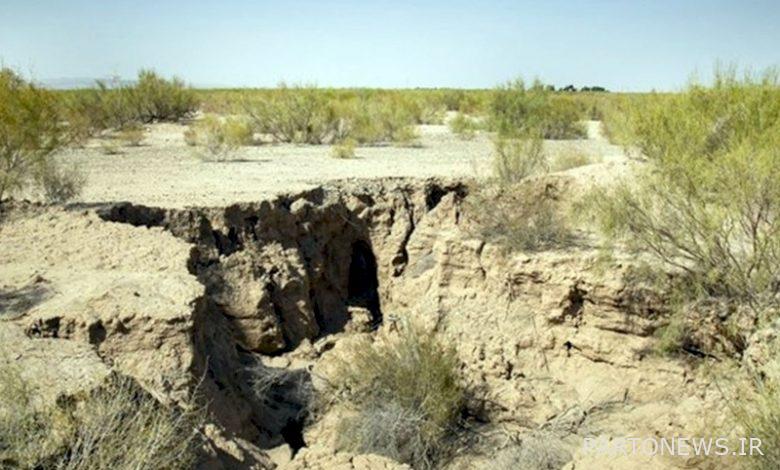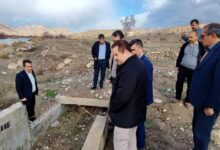Land subsidence is a threat to the life of Isfahan

Today, this historic world city is in an unequal battle, facing the scourge of drought, so that the significant reduction of groundwater in the Great Plain of Isfahan, which at the end of long drought and based on the disorganized exploitation of this national wealth, extends cultural and civilized life. This has seriously endangered the world city.
Isfahan is a city of history
Isfahan province is geographically located in the central axis of the central plateau of Iran so that this plateau from the north to the Great Alborz Mountains, from the west to the soaring Zagros Mountains and from the east to the scattered mountains of eastern and central Iran such as “Shirkuh” , “Taftan” and “Vulture” are limited and these mountains, like a triangle, surround this civilization-building plateau.
According to some paleontologists such as the Frenchman Roman Grishman, the central plateau of Iran experienced a period of rainfall more than fifteen thousand years ago, so according to some researchers, a large and shallow lake was formed in the heart of the central plateau of Iran. The ideas of Lake Titus were called.
Regardless of the correctness or incorrectness of this theory, today in different parts of the province, such as Kashan in the northern axis of Isfahan province or the cities of “Dolatabad” and “Khorzouq” in the northern axis of the historic city of Isfahan and also the village of “Kalhorud” in Shahinshahr and There is undeniable evidence of the existence of this great and mysterious lake.
However, with the end of the rainy season, the dry season began about 12,000 years ago on the central plateau of Iran, and the first man (caveman) whose social life traces in this region reach more than 40,000 years ago, left the cave and settled. It was from there that the age of culture and then civilization in this period gradually formed in the central plateau of Iran.
Undoubtedly, the existence of water has played an undeniable role in shaping the era of culture and then civilization, so the limited water resources in the central plateau of Iran such as “Zayandehrood” has always played a key role in the cultural and civilizational life of the people of this area.
During the dry season and the emergence of the central desert of Iran, which gradually followed in the footsteps of Lake Titus and the dense forests of the central plateau of Iran, the people of this land learned how to not only create a sustainable culture and civilization in the face of unkind nature. They made the world so that Isfahan in the fifth and sixth centuries and then in the eleventh and twelfth centuries AH along its life of several thousand years (in the Islamic era) was able to play a key role in the cultural and civilizational life of the Iranians. The eleventh and twelfth AH lunar city in the fields of various sciences such as literature, religious sciences, philosophy, mysticism, art and especially architecture and other sciences turned the great city world as the last manifestation of the Eastern world against the Western world. However, Isfahan was able to play a valuable role in shaping the rich culture and civilization of the Islamic world during this period.
Isfahan Climate
Throughout history, Isfahan has always been considered a part of the low rainfall areas of the country, so the people of the great plain of Isfahan, who do not see much high mountains around them, have depended on Zayandehrood water as the only water source of this vast plain.
Our ancestors in low rainfall and desert areas during their busy life have always been able to think and apply different strategies, the cultural and civilizational life of this ancient land so that the history of digging aqueducts along with the use of surface water in Iran to more than It dates back to 4,000 years ago, however, these aqueducts, some of which, including three aqueducts in the province of Isfahan, have been inscribed on the World Heritage List today, were an attempt to preserve life, as the late Dr. Ibrahim Bastani Parizi of the aqueduct He referred to them as the “desert epic” and called them the veins of human life in the roasted earth.
For nearly two decades now, the central plateau of Iran has been suffering from drought, so the continuation of drought along with population growth in this plateau on the one hand and limited water resources on the other hand has caused some officials knowingly or unknowingly as much as they could not only By creating different tributaries, they have transferred the water of Zayandehrood to different areas, but also the people by digging deep wells and in an action against the laws of digging historical aqueducts, the rest of these underground waters that had gradually accumulated in the heart of the earth over thousands of years. It is pulled out of the soil at once, and this causes the earth to gradually fall vertically, that is, to move downwards due to the emptying of groundwater aquifers in the form of subsidence and subsidence in the long run, which is also very dangerous. However, this phenomenon has been recognized by geologists as so dangerous that it has been referred to as “earth crust cancer” and is now, unfortunately, gradually spreading in 200 plains of the country, including the plain of Isfahan.
Land subsidence in Isfahan
During the nineties, some signs of landslides appeared in the plains of Isfahan, especially in the historic city of Isfahan, however, over the past two years, this phenomenon has become more serious and its dangers have always been warned by officials, experts and media owners in Isfahan. However, it should be noted that addressing this natural phenomenon, which is mainly caused by humans, must be accompanied by a completely scientific manner and with the expression of scientific citations and with clear clarity by the relevant organizations in order to achieve accurate and clear results for future claims. Found in this regard, it seems that mentioning a few points is not without merit:
- The need for support and assistance of the Deputy Governor for Civil Engineering and relevant institutions such as the General Directorate of Crisis Management to mobilize organizations related to this event such as Regional Water Organization, Road and Urban Development Organization, Agricultural Jihad Organization, Natural Resources Organization, Forests and Rangelands Organization, Cultural Heritage, Tourism Organization And handicrafts and municipalities of cities at risk of subsidence in order to identify and assess the current situation.
- The need for coordination in the study of population tissues in order to study the signs of subsidence, especially in the metropolis of Isfahan
- The need for a detailed study of the historical context of Isfahan separately in the two parts of the historical axes of the city and historical bridges in the Zayandehrood axis within the city of Isfahan, by experts, because the impact of Zayandehrood dry land on the foundations of historic bridges It should be examined and a logical conclusion reached.
- The need to follow up strongly, especially the officials, in order to have a permanent flow of Zayandehrood, because at present about 150 km of the Zayandehrood route, about 150 km of which is mainly located in the Great Plain of Isfahan, is dry, so the dryness of Zayandehrood and its tributaries Which is the only source of drinking water, agriculture and groundwater in Isfahan has now dried up and this has a direct impact on the lack of water injection and the gradual reduction of groundwater in the Isfahan plain.
- The need to teach the culture of water saving to citizens so that the metropolis of Isfahan now has a population of more than two million people and this, due to the smaller size of Isfahan in historical periods has caused a significant part of Zayandehrood water to be wasted in urban consumption.
- The need for a rapid change in the pattern of cultivation in agriculture from flooding to other existing patterns, as well as the need for necessary training for farmers in order to change their crop from crops that need water to crops that require less water.
- In this regard and during the past years in some areas of the province, the cultivation pattern has changed to cultivate some crops that need little water, such as pistachios and saffron, and this has not only reduced water consumption but also become a tourist attraction in the central regions. And has become the east of Isfahan province.
In any case, during different historical periods, Isfahan became a great city in order to extend the cultural and civilizational life of this great nation, the signs of which are always evident, so let’s try to become worthy heirs to our God-seeking and artist ancestors so that future generations can Let them be proud of us as their ancestors.
.

